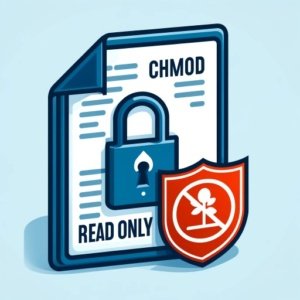Chmod Read-Only Permissions | A Unix/Linux User’s Guide

Maintaining data integrity and security on Unix/Linux servers at IOFLOOD often involves making files read-only using chmod. The chmod command, when configured to restrict write permissions, prevents unauthorized modifications to critical files. In this guide, we’ll explore the process of making a file read-only using chmod, to assist our bare metal cloud customers and fellow developers in safeguarding data and preventing accidental changes.
This guide will walk you through the process of using chmod to make a file or directory read-only. We’ll explore chmod’s core functionality, delve into its advanced features, and even discuss common issues and their solutions.
So, let’s dive in and start mastering chmod!
TL;DR: How Do I Make a File Read-Only Using Chmod?
To make a file read-only using chmod, you use the command
chmod 444 filename. This command changes the permissions of the file to read-only for all users.
Here’s a simple example:
chmod 444 myfile.txt
# Output:
# No output if the command is successful
In this example, we use the chmod 444 command to make ‘myfile.txt’ read-only. The ‘444’ in the command represents the permissions in the form of ‘user’, ‘group’, and ‘others’. Each ‘4’ stands for ‘read’ permission.
This is a basic way to use chmod to make a file read-only, but there’s much more to learn about file permissions and chmod. Continue reading for more detailed information and advanced usage scenarios.
Table of Contents
Understanding Chmod: The Basics
The chmod command, short for ‘change mode’, is a fundamental command in Unix and Unix-like operating systems, such as Linux. Its primary function is to change the permissions of files or directories.
When we talk about making a file read-only using chmod, we’re referring to setting the file’s permissions so that it can be read, but not modified or executed.
The ‘444’ Permission Code
The permission code ‘444’ is a numerical representation of the file permissions. In Linux, permissions are represented by three numbers, each ranging from 0 to 7. These numbers correspond to the permissions for the ‘user’, ‘group’, and ‘others’ respectively.
In the case of ‘444’, each ‘4’ stands for ‘read’ permission. Thus, by using chmod 444, we’re setting the file to be readable by all users, but not writable or executable.
Let’s see this in action with a different file:
ls -l example.txt
# Output before chmod:
# -rw-r--r-- 1 user group 0 date example.txt
chmod 444 example.txt
ls -l example.txt
# Output after chmod:
# -r--r--r-- 1 user group 0 date example.txt
In this example, we first use ls -l to view the current permissions of ‘example.txt’. The output shows that the user can read and write the file, while the group and others can only read it.
After running chmod 444 example.txt, we check the permissions again. Now, the output shows that the file is read-only for all users.
This basic use of chmod is the first step in mastering file permissions in Linux. As we’ll see in the following sections, chmod has much more to offer for those looking to fine-tune their file permissions.
Advanced Read-Only Methods
While making a single file read-only is straightforward, you might encounter a scenario where you need to make an entire directory and its contents read-only. This is where the ‘-R’ (or ‘–recursive’) option comes into play.
The ‘-R’ option tells chmod to change the permissions of the directory and its contents recursively.
Recursive Changes with ‘-R’
Let’s say we have a directory named ‘mydir’ with several files in it. Here’s how you can make ‘mydir’ and all its contents read-only:
ls -l mydir
# Output before chmod:
# total 0
# -rw-r--r-- 1 user group 0 date file1
# -rw-r--r-- 1 user group 0 date file2
chmod -R 444 mydir
ls -l mydir
# Output after chmod:
# total 0
# -r--r--r-- 1 user group 0 date file1
# -r--r--r-- 1 user group 0 date file2
In this example, we first use ls -l mydir to view the current permissions of the files in ‘mydir’. The output shows that the user can read and write the files, while the group and others can only read them.
After running chmod -R 444 mydir, we check the permissions again. Now, the output shows that all the files in ‘mydir’ are read-only for all users.
This advanced use of chmod allows you to quickly and efficiently manage the permissions of a large number of files. It’s a powerful tool that can save you a lot of time and effort.
Chattr: An Alternative to Chmod
While chmod is a versatile tool for managing file permissions, it isn’t the only way to protect your files from unwanted changes. For those looking for an alternative, the chattr command is an excellent choice.
The chattr command changes the attributes of a file or directory. One of these attributes is the ‘immutable’ attribute, which, when set, prevents the file from being modified, deleted, or renamed, even by the root user.
Here’s how you can set the immutable attribute using chattr:
sudo chattr +i myfile.txt
lsattr myfile.txt
# Output:
# ----i--------- myfile.txt
In this example, we use sudo chattr +i myfile.txt to set the immutable attribute of ‘myfile.txt’. We then use lsattr myfile.txt to view the file’s attributes. The output shows that the ‘i’ (immutable) attribute is set.
Changing File Ownership
Another way to protect a file from changes is to change its ownership. You can do this using the chown command. By changing the file’s owner to root, you can prevent non-root users from modifying the file.
Here’s how you can change the owner of a file to root:
sudo chown root:root myfile.txt
ls -l myfile.txt
# Output:
# -r--r--r-- 1 root root 0 date myfile.txt
In this example, we use sudo chown root:root myfile.txt to change the owner and group of ‘myfile.txt’ to root. We then use ls -l myfile.txt to view the file’s permissions. The output shows that the file is now owned by root.
While these alternative approaches can offer more control or protection than chmod in certain scenarios, they also come with their own considerations. The chattr command requires root privileges and doesn’t affect all file systems, while changing the file’s ownership can have unintended side effects if not handled carefully.
Overcoming Common Chmod Hurdles
While using chmod to make files read-only is generally straightforward, you might encounter some common issues. Let’s discuss these potential problems and how to solve them.
‘Permission Denied’ Errors
One of the most common issues you might face is a ‘Permission denied’ error. This error typically occurs when you try to change the permissions of a file you don’t own.
Here’s an example of what this might look like:
chmod 444 protectedfile.txt
# Output:
# chmod: changing permissions of 'protectedfile.txt': Operation not permitted
In this scenario, you’re trying to change the permissions of ‘protectedfile.txt’, but the system won’t let you because you’re not the file’s owner. To resolve this, you can use the sudo command to execute chmod with root privileges:
sudo chmod 444 protectedfile.txt
# Output:
# No output if the command is successful
Now, with root privileges, you’re able to change the permissions of ‘protectedfile.txt’. Remember, with great power comes great responsibility. Always be careful when using sudo to avoid making unintended changes.
Best Practices and Considerations
When using chmod, it’s important to follow best practices to maintain the security and integrity of your files. Here are a few tips:
- Always check the current permissions of a file before changing them. This can help you avoid accidentally removing necessary permissions.
Be cautious when using the ‘-R’ option with chmod. It can be easy to accidentally change the permissions of more files than intended.
Avoid using chmod with root privileges unless absolutely necessary. It’s safer to change the ownership of a file to your user, then change the permissions as needed.
By understanding these common issues and following best practices, you can use chmod effectively and efficiently.
Unveiling Linux File Permissions
Before diving deeper into the chmod command and its usage, it’s crucial to understand the fundamentals of Linux file permissions. These permissions determine who can read, write, or execute a file or directory in a Linux system.
What Does ‘Read-Only’ Mean?
When a file is set to ‘read-only’, it means that users can view the file’s contents, but they cannot modify or delete the file. In other words, the file is ‘read-only’ and not ‘write’ or ‘execute’.
Here’s an example of a read-only file:
ls -l readonly.txt
# Output:
# -r--r--r-- 1 user group 0 date readonly.txt
In this example, the permissions of ‘readonly.txt’ are set to ‘r–r–r–‘. This means that all users can read the file, but no one can write to it or execute it.
Users, Groups, and Others
In Linux, file permissions are divided into three categories: ‘user’, ‘group’, and ‘others’. The ‘user’ is the owner of the file, the ‘group’ consists of a set of users who share the same permissions and user rights, and ‘others’ refers to all other users.
When you view a file’s permissions using ls -l, you’ll see a string of 10 characters. The first character indicates the type of the file (e.g., ‘-‘ for regular files, ‘d’ for directories), and the following nine characters represent the permissions for the ‘user’, ‘group’, and ‘others’ in that order.
Each set of three characters indicates the read (r), write (w), and execute (x) permissions. For example, ‘rwx’ means that the user, group, or others can read, write, and execute the file.
Here’s an example:
ls -l myfile.txt
# Output:
# -rw-r----- 1 user group 0 date myfile.txt
In this example, the permissions of ‘myfile.txt’ are set to ‘rw-r—–‘. This means that the user can read and write the file, the group can read the file, and others have no permissions.
Understanding these fundamentals is key to mastering file permissions in Linux and using the chmod command effectively.
File Permissions in System Security
Understanding and properly managing file permissions is a vital aspect of system security and data integrity in Linux. Setting a file to read-only using chmod is not just a technical operation, but a crucial security measure.
When a file is set to read-only, it prevents unauthorized modification of the file’s content. This is particularly important for system files and configuration files, which can cause system instability or security vulnerabilities if improperly modified.
Linux User Management and File System Security
Beyond chmod, there’s a whole world of Linux user management and file system security to explore. Learning how to add, delete, and manage users, understanding the role of root and sudo, and knowing how to set up and manage user groups can all contribute to a more secure and efficient system.
File system security involves more than just file permissions. It includes understanding and managing ownership and group membership of files, using special permissions like SUID, SGID, and sticky bit, and even file system attributes like those managed by the chattr command.
Further Resources for Linux Security Mastery
For those interested in delving deeper into Linux system security and file permissions, here are some valuable resources:
- The Linux Command Line: A Complete Introduction – This book offers a comprehensive introduction to the command line, including file permissions and security.
Linux Security – This Coursera specialization covers a range of topics related to Linux security, including user management and file permissions.
Linux File Permissions Explained – This guide provides a detailed explanation of Linux file permissions and includes numerous examples.
Recap: Chmod Read-Only Tutorial
In this comprehensive guide, we have unraveled the intricacies of using chmod to set files and directories to read-only in Linux. We’ve explored the basic usage of chmod and how the ‘444’ permission code can make a file read-only. We’ve also delved into advanced usage scenarios, such as making an entire directory and its contents read-only.
We began with the basics, demonstrating how to use chmod to change a file’s permissions to read-only. We then progressed to more advanced topics, such as using the ‘-R’ option to recursively change the permissions of a directory and its contents. Along the way, we explored alternative approaches to protecting files from changes, such as using the chattr command and changing the file’s ownership.
We also tackled common issues you might encounter when using chmod, such as ‘Permission denied’ errors, and provided solutions to these problems. Additionally, we discussed best practices and considerations when using chmod, emphasizing the importance of checking current permissions and being cautious when using the ‘-R’ option.
Here’s a quick comparison of the methods we’ve discussed:
| Method | Pros | Cons |
|---|---|---|
| chmod | Simple, flexible, does not require root privileges | Can lead to ‘Permission denied’ errors if used on files owned by others |
| chattr | Can make files immutable, preventing all modifications | Requires root privileges, does not affect all file systems |
| chown | Can change ownership of files, providing more control over permissions | Can have unintended side effects if not handled carefully |
Whether you’re just starting out with chmod or you’re looking to deepen your understanding of file permissions in Linux, we hope this guide has been informative and helpful. Understanding file permissions and knowing how to manage them effectively is a vital skill for any Linux user. Now, you’re well equipped to handle these tasks with confidence. Happy coding!


